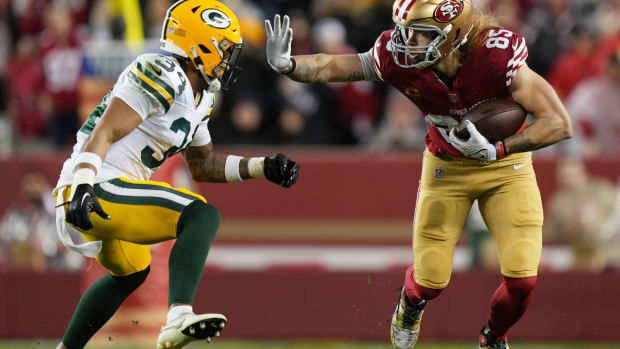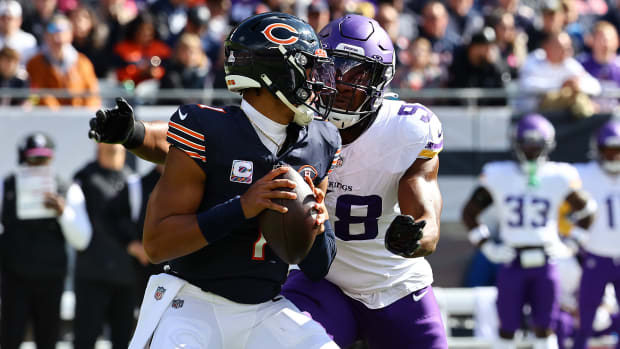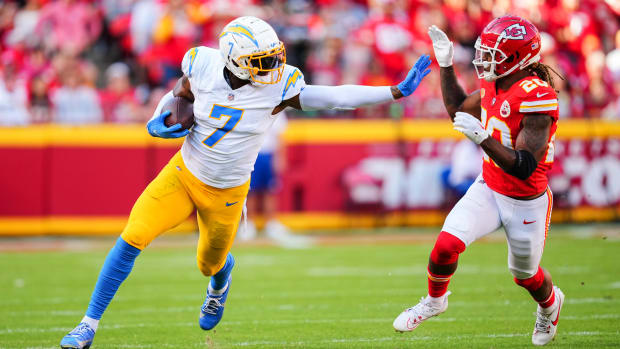Bears Mid-Term Report Card: Maximizing Some Good Fortune
If the Bears want to know about the meaning of a season's second half, they only need to look as far as Sunday's opponent.
The Tennessee Titans last year went 2-4 to start the season, were still below .500 after nine games (4-5), then closed with five wins in their last seven and made a strong run at getting to the Super Bowl.
Teams put themselves in position to make the playoffs with the first half, and the Bears have done this.
How they close will determine how the team is remembered.
At this point the Bears have put up passing grades everywhere. It's difficult to fail with a winning record.
Yet, the trend definitely is pointing down in many areas.
Here are the mid-term grades.
Quarterbacks: D+
One reason win-loss records for quarterbacks are deceiving is they get credit for wins when they contribute nothing. Rex Grossman got a winning start for the "they are who we thought they were" game, but it was the defense earning the win. Mitchell Trubisky gets credit for a 3-0 record as a starter in the first three games but contributed nothing but a 17-point deficit in Week 3, and went into hibernation in the second half of Week 2. He played three good quarters this year—the fourth quarter against Detroit and first two quarters against the Giants. Nick Foles hasn't been the success many expected after his debut against the Falcons. An 80.2 passer rating and 6.1 yards per attempt are worse than the numbers put up by Trubisky last year. Admittedly, he faced a difficult situation with picking up the offense minus an offseason of work in it, but this is the task all teams faced this year when they made quarterback changes and Foles was supposed to know this offense when he was acquired. More passes downfield like last week to Darnell Mooney are needed. Foles was missing early on deep attempts, but it's possible as the season has gone on he'll get more in tune with the receivers.
Running Backs: C-
David Montgomery has been very critical of himself and what he said was true. He has to envision his path more, and stick to it without hestitation and cutting back so much. He has to trust the run. He is No. 1 in the NFL according to Pro Football Focus for producing missed tackles. Like last year, though, too many of the misses come in his backfield. His 3.8-yard average per carry is a very slight improvement on last year. He has become a bigger part of the passing game with 27 catches, two more than all of last year. Tarik Cohen's loss has been devastating because it removes speed, versatilty and the element of surprise from a relatively slow backfield. Cordarrelle Patterson's switch to the backfield started out well and has crashed. He's averaging only 2.9 yards a run. He can't get the ball running laterally and make a play because it takes him a few seconds running straight to build up speed. The only way he contributes this year is if they put him in the I and have him start running stretch plays in outside zone blocking, and even then he doesn't have the experience as a back to know when to stick with his blocking. Ryan Nall has been a non-entity.
Wide Receivers: C
This is a case of mixed production. Darnell Mooney is well beyond a pleasant surprise and a few more deep balls can stamp himself as a real impact player. Mooney has more catches than rookie receivers Henry Ruggs, Jerry Jeudy, Jalen Reagor, Chase Claypool, Michael Pittman and KJ Hamler and they were all taken in the first two rounds, not the fifth like Mooney. The trouble is, until last week he had more catches than teammate Anthony Miller, as well. The Bears need more catch-and-run and plays downfield from Miller, who has 27 receptions but only 9.7 yards a catch. The only blemish on Allen Robinson's production are three bobbled attempts at 50-50 balls that turned to interceptions. Otherwise, he's been brilliant. No one in football sells out his body more to make a given catch than Robinson, and it's a shame he has to do it so often. Speaking of blemishes, Javon Wims' contribution this year is a blemish on the Bears season—the sucker punch, fight and supsension. Ted Ginn Jr. had one contribution—the fourth-down catch that made possible the comeback win over Atlanta.
Tight Ends: C-
With 29 catches, Jimmy Graham is on pace for a total more like some of his better years in the second half of his career. Initially the Bears used him well in the red zone, as well. HThe trouble is, this has tailed off and he's rarely good for a downfield catch. Demetrius Harris hasn't produced much more than dropped passes. The Bears say he blocks well, and also talk about Graham's willingness to block. Considering how poorly the Bears have run, they can't be blocking too well. Cole Kmet's advancement has come in small increments, although his few big plays give hope he'll eventually be a big part of the attack.
Offensive Line: D
The only reason they avoid an F is their start as run blockers let the offense charge out to 11th in the league in rushing. They've since dropped 20 places and have gone through a stretch of five straight games without 100 yards rushing as a team. Now the injuries and COVID-19 situation make a recovery less likely. Germain Ifedi hasn't been a disappointment, but hasn't produced well enough to warrant bringing him back yet on a new contract. Tackles Bobby Massie and Charles Leno Jr. have played better generally than last year but only nine teams have allowed more sacks than the Bears. Dump much of theiir 31st ranking as a rushing team on the offensive line. They're a very limited group.
Defensive Line: B-
The inability to make up for losing Eddie Goldman to a COVID-19 opt-out has weighed heavily on the defense overall. Bilal Nichols has improved at nose tackle but John Jenkins' injuries have hurt and the other players tried, like Brent Urban, have only sporadically made plays. The steady, constant occupation of interior blockers supplied by Goldman just isn't there. Akiem Hicks' only flaws this year have been the penalties. His nine penalties lead the team, of which at least three were questionable calls. Roy Robertson-Harris suffered a shoulder injury the last game and hasn't been the play maker he had been in the past. With only 10 tackles, he's well off last year's season pace of 30. This was probably to be expected because he benefited in the past from having Goldman on the field. Mario Edwards has been a real depth find because of his versatility.
Linebackers: B
Khalil Mack's play has been strong despite ankle and knee issues. With 6 1/2 sack and two forced fumbles, he's on a path for bigger impact numbers than his other two Bears seasons. He's getting fewer pressures on pass rush but making far more tackles than in both other Bears seasons. Robert Quinn has had a disappointing first half by all measures. With only one sack, seven tackles and two quarterback hurries, he is on track for his least productive season ever and doesn't even play half the downs. Outside linebacker backups James Vaughters and Barkevious Mingo have had solid first halves making up for Quinn's lack of production. Mingo has 23 tackles with three starts and is playing less than 40% of the snaps. He's on a tackles pace close to what he had in Seattle when he was a starter. Both inside linebackers have taken a roller-coaster ride in the first half. Danny Trevathan's overall play has picked up over the last three games and he had his best game last week, and Roquan Smith's last four games have been higher overall than the first four as he made more big tackles in the open field.
Secondary: A -
Tashaun Gipson has proven an ideal safety complement to Eddie Jackson with one exception. They need more physical play from him in the running game. He's made key plays in pass coverage. Jackson would have had a memorable first half of the schedule if not for the officials taking away a pair of touchdown returns. Jackson is missing fewer tackles, although he gave up some completions early and has a high 105.8 passer rating against when targeted. Kyle Fuller's numbers look better than his last two seasons, which were Pro Bowl years. He doesn't have the interceptions, with just one, but has allowed less than 50% completions and hasn't been close to that the last two years. He's been a physical, intimidating presence. Rookie Jaylon Johnson hasn't maintained the pace he started at but has given up just two TD passes and still has yielded completions on only 50 percent of passes when targeted. Buster Skrine has been the defender offenses picked on when they weren't trying to attack the rookie, and he's given up some catches. What Skrine has done well is tackle. He has only 9.5% missed tackles, which is a low percentage for a slot cornerback. Overall, the secondary gets much of the credit for why the defense ranks No. 1 defending third-down plays and preventing red zone touchdowns.
Special Teams: B
Cordarrelle Patterson leads the NFC's regular return men in kick return average (27.5 per return), while Cairo Santos is giving the Bears the consistent kicking they've lacked since Robbie Gould left. He's been more dependable from a variety of ranges than Eddy Pineiro was. Considering Pat O'Donnell has had to punt more times than every punter except the Jets' Braden Mann, his 46.4-yard average is spectacular. He is tied for second in the NFL in punts downed inside the 20.
Coaching: C
In-game decisions on how to use the clock and timeouts has been an adventure, and hurt them last week in the first half. Too much confusion in huddles and when the offense lines up falls into the laps of Matt Nagy and offensive coordinator Bill Lazor. Chuck Pagano has the secondary excelling at situational football, and if not for a few officials' calls they'd have the turnovers to match their spectacular red-zone and third-down coverage numbers. Nagy made the right call on yanking Mitchell Trubisky because they were about to lose to a bad football team, he needs to keep coming up with less predictable game plans to give them a chance against stronger opponents. And the Bears above all else must find a way to score after halftime. Halftime adjustments are always overrated because there's no time to make them in the NFL, but they do need to have a few counter punches in the second half to get into the end zone after being outscored 49-7 in third quarters.
General Manager: C-
The Jimmy Graham move by Pace at least brought them a functional tight end. While Foles has struggled, he at least gives them an opportunity to win with a different style player than they had with Trubisky. The Germain Ifedi and Barkevious Mingo signings have been wins for Pace, as well. The big mistake so far looks like it was Robert Quinn. If they had to let Leonard Floyd leave to save money, they easily could have found a much cheaper option at outside linebacker who could get more than one sack and two quarterback hits in the first half of the season. The draft Pace had looks to have produced two immediate successes and another with potential in Kmet. Pace failed to get another offensive lineman via trade or signing and the Bears have to live with this failure with a makeshift line heading into Tennessee.
Overall B-
The way they got to 5-3 is about as unlikely a scenario as anyone could imagine. Changing quarterbacks, coming back from 16- and 17-point deficits in the fourth quarter of games, and a 13-point deficit against Tampa Bay, but being above .500 is gold at this point in the year.
Twitter: BearDigest@BearsOnMaven




